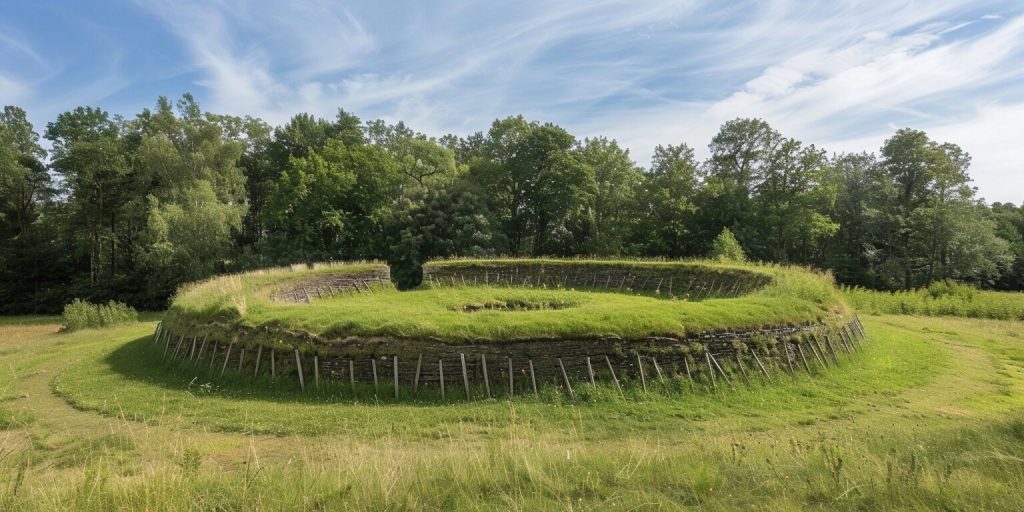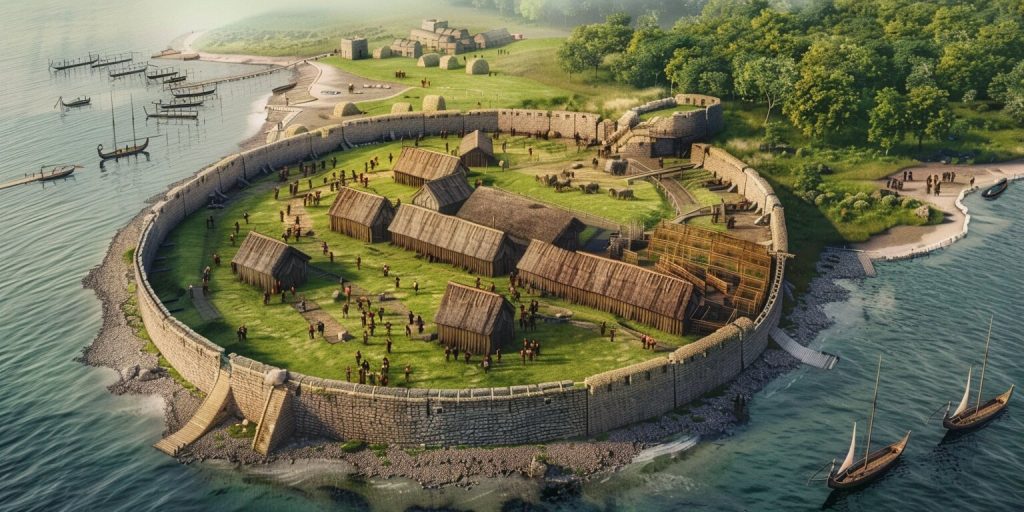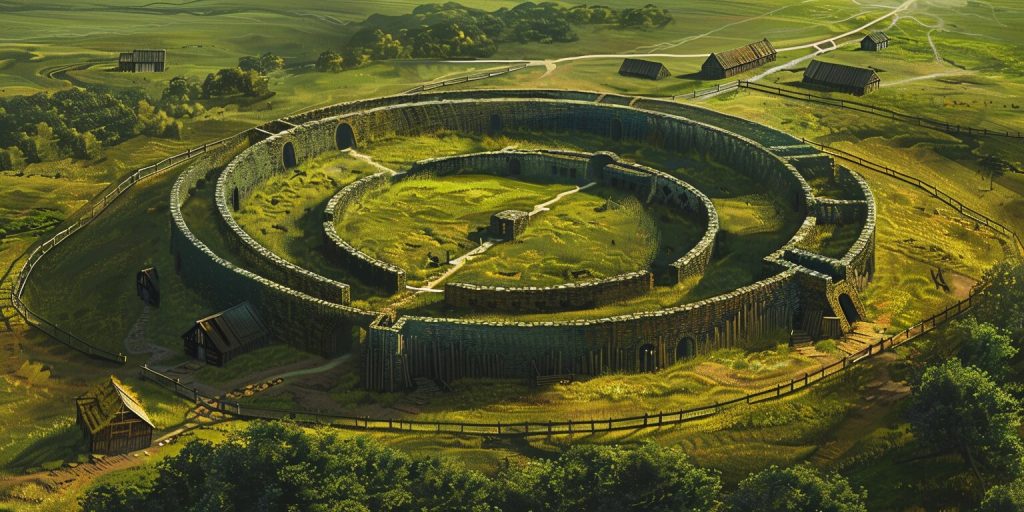Daily Life in the Viking Age, Viking Heritage, Vikings
Guardians of the North: The Strategic Importance of Viking Ring Fortresses
Viking ring fortresses were key during the Viking Age, and places like Nonnebakken in Odense stand as a testament to their importance. They were the guardians of the North, often based in ring castles. These strongholds were in Denmark, such as Fyrkat and Aggersborg, and played a big role in defending important areas and controlling trade paths.
The Vikings were known for their military skills. The design of their fortresses showed their advanced tactics. They had high walls and complex layouts, which made them strong defenses and symbols of power.
These fortresses were placed in strategic spots, much like the strategic placement of ring castles. They let the Vikings watch over and protect important regions. Being on trade routes helped the Norsemen keep control of valuable commerce in their lands.
Looking into the Viking Age, we see these ring fortresses were more than just strongholds; they were integral to Viking-age society. They were key places that helped the Vikings protect their lands, show their power, and keep their interests safe in the North.
Exploring the Viking Legacy
The Viking Age was a key time in European history. It was marked by the Vikings’ bold actions and their wide influence. From the late 8th century to the 11th century, they grew their territories by sea and set up successful settlements in many places.
The Significance of the Viking Age
This era was a time of great exploration, trade, and cultural sharing. The Vikings, mainly from Scandinavian countries, sailed the North Atlantic, Baltic, and Mediterranean seas. They reached as far as North America, the Middle East, and Central Asia, bringing knowledge of ring forts with them.
Through their voyages, they made a lot of money through trade and greatly impacted politics. This influenced the construction of Viking-age ring fortresses and changed the political map of their time.
Insights into Danish Viking Fortresses
Denmark’s Viking fortresses are important archaeological sites. They show us how the Vikings built their defenses and architecture. Borgring and Trelleborg are two well-known fortresses.
These fortresses were built with great care. They had circular walls, high ramparts, and smart entrances. They give us a peek into the Vikings’ military and social ways.
UNESCO World Heritage Recognition
The world has recognized the importance of Danish Viking fortresses, especially the Danish Viking Age ring fortresses. They are now UNESCO World Heritage sites, preserving the historical legacy of Viking strongholds across Scandinavia. This shows how vital these sites are for understanding the Viking culture.
Visitors can see these fortresses and learn about Viking history. It helps us appreciate the culture and history of that time more deeply.
Archaeological Marvels of Ring Fortresses
Exploring the past is like finding hidden treasures. The Viking ring fortresses of Borgring and Trelleborg are perfect examples. They offer deep insights into the Viking Age and their fortification methods.
Discovering Borgring and Trelleborg
Borgring was found on the Danish island of Zealand in 2014 through aerial photos. It showed a circular site with walls and a courtyard. Its good condition and strategic spot made it a key archaeological find.

Trelleborg is one of Denmark’s most well-preserved Viking fortresses. Built during King Harald Bluetooth’s time, the Trelleborg Viking fortress has a unique design that is particularly noticeable in the fortress of Aggersborg. It has a circular wall and four gates, showing the Vikings’ military skill.
Excavation Techniques and Findings
Archaeologists have used many techniques to uncover these ancient sites. They’ve found weapons, jewelry, tools, and everyday items, which tell us about the Vikings’ lives and daily activities.
Archaeologists have studied the ruins to piece together how these fortresses looked and worked. This tells us about the Vikings’ military setup and defense tactics.
Geometric Design of Viking Age Fortifications
The Viking ring fortresses are known for their geometric design, which follows exact measurements and symmetrical patterns. This shows the Vikings’ engineering skills.
This design made the fortresses stronger and showed power and authority, qualities epitomized by Viking-age ring fortresses. The big structures and smart placement showed their control over the area.
The discoveries at Borgring and Trelleborg Viking fortresses, along with the excavation methods and geometric insights, give us a peek into Viking Age fortifications. These wonders amaze and inspire us, showing us the advanced civilization of the North.
Legends and Lore Surrounding Ring Fortresses
The Viking ring fortresses have amazed people for centuries, a testament to the sophistication of Viking-age ring fortresses. Their stories tell of bravery, conquest, and mystery. These ancient places in Denmark show us the world of the Vikings, particularly through the excavation of Danish Viking Age ring fortresses.
King Harald Bluetooth’s Influence
King Harald Bluetooth is a key figure linked to these fortresses. He was a powerful Viking leader. He helped build and make these settlements important for Denmark’s defense.
The Role of Communication in Viking Castles
Communication was crucial in Viking castles, and Nonnebakken is a prime example of their sophisticated signaling systems. These systems helped with quick coordination and defense, especially evident in fortresses built during the 980 AD era. The design of these fortresses ensured messages could be sent fast and safely, with sites like Køge demonstrating these innovations.
The Vikings used watchtowers and signal fires to send messages far and wide, which was crucial for fortresses spread across Jutland. This helped them respond quickly and plan strategies.
Sindbæk and Archaeological Interpretations
Sindbæk, a famous archaeologist, has greatly helped us understand Viking ring fortresses, particularly through his work on sites like Nonnebakken and Fyrkat. He studied artifacts and the remains of Viking life, giving us new insights into Viking customs and society.
Reviving the History of Viking Ring Fortresses
Today, we’re working hard to save the history of Viking ring fortresses. These amazing structures tell us a lot about the Viking Age and Danish culture, and they are very important to our history.
Modern-Day Preservation Efforts
We’re working to protect Viking ring fortresses and their contents. This includes regular upkeep, fixing structures, and protective steps to keep them safe. We also restore them to look like they did before, with excavation projects often taking place in places like Slagelse and Køge.
Archaeologists are key in this effort, especially when they excavate ring forts. They use new methods to find artifacts and study them. This helps us learn more about Viking settlements and culture.

Teaching people about Viking history is also crucial. Museums and heritage centers have exhibits, tours, and programs for everyone. These help people learn about Viking history, how they built their fortresses, and why they were important, including their strategic locations throughout Scandinavia.
Touring the Viking Age Sites in Denmark
Denmark is full of Viking Age sites for visitors to see. Places like Trelleborg and Borgring let you see Viking architecture up close. You can learn about the lives of the Vikings who lived there, especially through excavations conducted at sites like Slagelse.
Trelleborg Viking fortress is in the southwest with an earthen rampart and a moat. It reveals much about the Viking military and social life.
Borgring is a unique ring fortress in Zealand. Its design shows the Vikings’ skill in planning and building, attributes that can also be seen in fortresses such as Fyrkat, a notable Viking-age ring fortress.
Visiting these sites lets you see history come alive, connect with Viking heritage, and see how important ring fortresses were in Danish history, particularly the Danish Viking Age ring fortresses.
Bottom Line
Viking ring fortresses are more than just old ruins; sites like Fyrkat and Aggersborg in Jutland highlight their significance. They show the military strength and smart planning of the Vikings back then. With their detailed designs and advanced building methods, these forts prove how important defense was in ancient times. Even after many years, these sites still amaze us with their deep historical and cultural value.
Looking into the Viking ring fortresses lets us peek into the past and learn about the Vikings’ lives and tactics. From the well-kept Borgring to the famous Trelleborg, each fort tells its own story and shares new discoveries. Archaeologists have found artifacts that tell us about Viking traditions and life. The forts’ geometric shapes show how carefully they were planned and built.
Stories and legends about the ring fortresses make them even more fascinating. King Harald Bluetooth and his impact on these forts are really interesting. Archaeologist Sindbæk has spent years studying the sites and uncovering their secrets.
Now, efforts are being made to keep the Viking ring fortresses alive for the future. By carefully restoring and preserving these sites, they can be enjoyed by visitors and future generations. Visiting these Viking age sites in Denmark lets you dive deep into history, admire the architecture, and see the legacy of Viking warriors. In short, Viking ring fortresses are not just old ruins; they show human creativity, military tactics, and the spirit of exploration that lasts.

